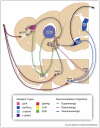Neurobiological mechanisms of social attachment and pair bonding
- PMID: 26146650
- PMCID: PMC4486624
- DOI: 10.1016/j.cobeha.2015.01.009
Neurobiological mechanisms of social attachment and pair bonding
Abstract
Species have evolved diverse social behavior and mating strategies in response to selective forces in their environments. While promiscuity is the predominant mating strategy across most vertebrate taxa, convergent evolution of monogamous mating systems has occurred multiple times across distant lineages. Monogamous behavior is thought to be facilitated by a neurobiological capacity to form and maintain selective social attachments, or pair bonds, with a mating partner. The neural mechanisms of pair bonding behavior have been investigated most rigorously in Microtine rodents, which exhibit diverse social organizations. These studies have highlighted mesolimbic dopamine pathways, social neuropeptides (oxytocin and vasopressin), and other neural systems as integral factors in the formation, maintenance, and expression of pair bonds.
Figures

References
-
- Hofmann HA, Beery AK, Blumstein DT, Couzin ID, Earley RL, Hayes LD, Hurd PL, Lacey EA, Phelps SM, Solomon NG, et al. An evolutionary framework for studying mechanisms of social behavior. Trends Ecol Evol. 2014;29:581–589. - PubMed
-
-
Sun P, Smith AS, Lei K, Liu Y, Wang Z. Breaking bonds in male prairie vole: long-term effects on emotional and social behavior, physiology, and neurochemistry. Behav Brain Res. 2014;265:22–31. The authors investigate affiliative, anxiety-like, and depressive-like behaviors, circulating stress hormone levels, and neuroplastic changes in the OT, AVP, DA, and CRF systems following partner loss. They find that loss of a bonded partner substantially impacts circulating stress hormones, neural plasticity in neuropeptide systems, and depressive-like and anxiety-like behavior.
-
Grants and funding
LinkOut - more resources
Full Text Sources
Other Literature Sources
